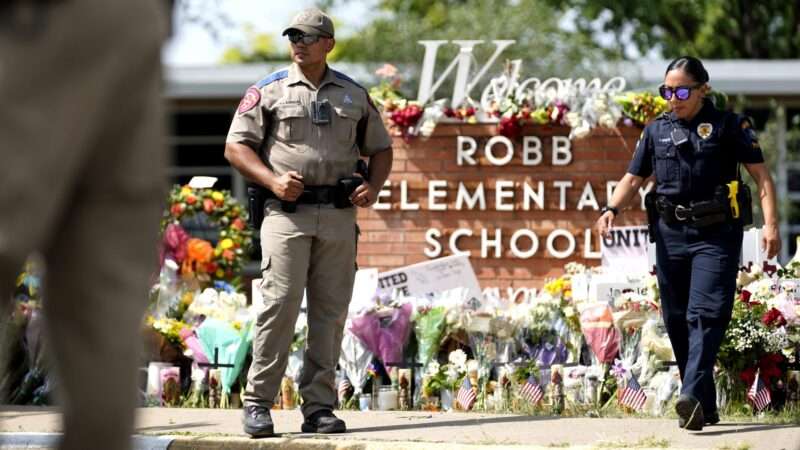
As a backlash to last year's disruptive Black Lives Matter protests, many Americans have gone out of their way to show support for police officers. In my conservative community, those blue-striped back-the-badge flags seem to outnumber Old Glory—and political yard signs eagerly boast law-enforcement endorsements.
Police unions emphasize heroic "thin blue line" themes, as they portray officers as the only thing standing between civil society and disorder. Individual police occasionally act courageously, but such portrayals are vastly overblown. In my years covering these issues, I've found officers almost always behave like self-protecting bureaucrats rather than selfless heroes.
As Americans debate the proper response to the horrific mass shooting of schoolchildren in Uvalde, Texas, it's important to dispense with our fanciful ideas about how police agencies operate. Toward that end, Uvalde's school police chief and local police officials have provided Americans with a remarkable case study of real-world ineptitude.
Americans seem shocked by how police reacted while 18-year-old Salvador Ramos was shooting up Robb Elementary School, where he gunned down 19 children and two teachers. Ramos reportedly began firing at 11:33 a.m. Police reportedly arrived quickly, but didn't breach locked classroom doors until 12:50, as trapped kids made desperate 911 calls.
Essentially, law enforcement behaved like armed bureaucrats. Large numbers of cops showed up. They hid behind walls to protect themselves. They milled around, conferred, and secured the perimeter, as the shooter emptied his weapon on helpless kids. They certainly wrote reports. As one headline noted, "Police delays may have deprived Texas schoolchildren of lifesaving care, experts say." That's a safe bet.
A few other items reinforce the bureaucratic tendencies of police agencies. On Thursday, police threatened to arrest journalists who gathered at the school district headquarters, which shows that officers often can be proactive when it suits them. Second, state officials accused school police of refusing to cooperate with a Department of Public Safety investigation after Texas officials criticized their inaction. Police offered shifting explanations.
Finally, ABC News reported that in March "the Uvalde school district hosted an all-day training session for local police and other school-based law enforcement officers focused on 'active shooter response.'" So the police can't pull out their usual flaccid, all-purpose response: "more training." In a few months, police will no doubt be handing out valor medals. The city department already released a statement praising its officers' actions.
Before you get too angry, remember that this is not unusual. It's a pattern, not an aberration. The nation has so many mass shootings that it's hard to keep track of them, but you'll find the same complaints after each one. In truly dangerous scenarios, police have turned the "Blue Lives Matter" mantra into, "Only Blue Lives Matter."
Police officials insist they changed their active-shooter protocols after the 1999 massacre at Columbine High School in Colorado, where two young men murdered 13 people and then killed themselves, as SWAT teams waited to engage. As CNN reported, that "watershed event" led police nationwide to head to the sound of gunfire rather than simply protect the perimeter and wait.
Yet look at how other shootings transpired. In 2018, Nikolas Cruz murdered 17 students in a high school in Parkland, Fla. As Cruz wandered the halls for 58 minutes, the school's officer reportedly "drew his gun but failed to go in," the Sun-Sentinel reported. "Instead, he took cover between two other buildings.… Instead of ordering deputies toward the building, (he) used his radio to order a school lockdown. More deputies arrived, but hung back even though they could hear the gunfire."
"As the largest mass shooting in modern U.S. history began to unfold, an off-duty police officer working at a gay nightclub exchanged gunfire with the suspect," CBS reported, with regards to a 2016 mass shooting in Orlando. "But three hours passed before one of the nation's most revered SWAT teams stormed the building and brought the attack…that left 49 people and the gunman dead to an end." Some police still defend that response.
It's hard to believe that anything substantive has changed since Columbine, which wasn't the first time police officials claimed to have revised their approach. In 1984, James Oliver Huberty fired semi-automatic weapons at McDonalds patrons in San Ysidro, killing 21. Police arrived within four minutes—but waited more than an hour before engaging.
As a lawsuit related to that shooting makes clear, the government (unlike the private sector) has virtually no liability when its failure causes the loss of life. Police agencies have won court victories affirming that they have no legal duty to protect anyone. Whenever police use deadly force, they say they did so because they feared for their lives. Defend it if you choose, but don't call it heroic.
At the very least, we cannot expect that police officers always will protect us. Until Americans face that reality, we'll never create effective policies to combat mass shootings.
This column was first published in The Orange County Register.
The post Uvalde Shows Once Again That Cops Are Just Armed Bureaucrats appeared first on Reason.com.







